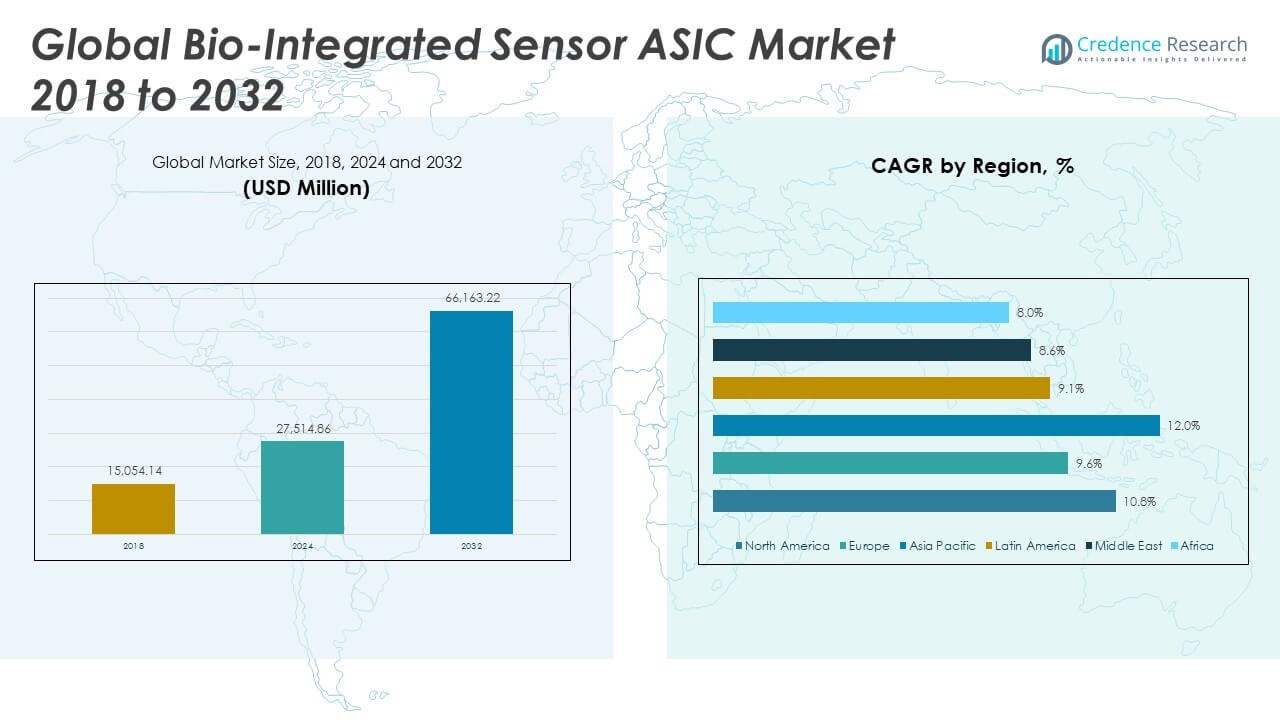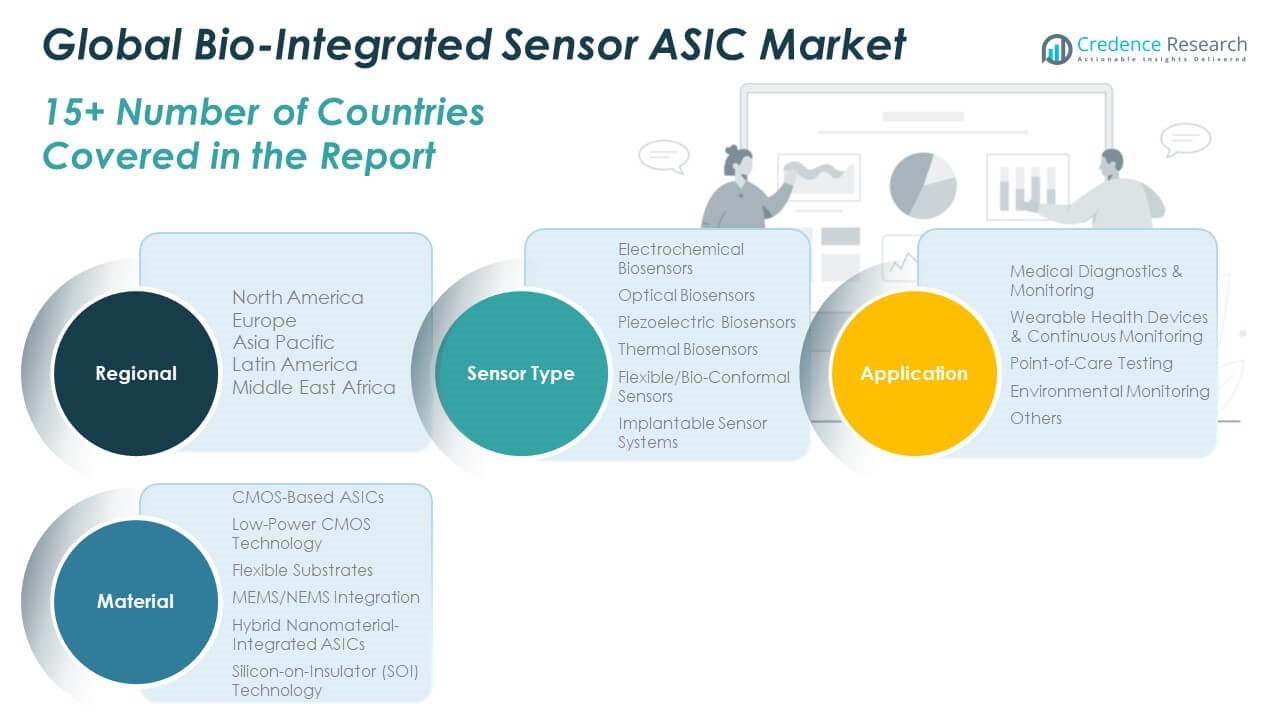CHAPTER NO. 1 : GENESIS OF THE MARKET
1.1 Market Prelude – Introduction & Scope
1.2 The Big Picture – Objectives & Vision
1.3 Strategic Edge – Unique Value Proposition
1.4 Stakeholder Compass – Key Beneficiaries
CHAPTER NO. 2 : EXECUTIVE LENS
2.1 Pulse of the Industry – Market Snapshot
2.2 Growth Arc – Revenue Projections (USD Million)
2.3. Premium Insights – Based on Primary Interviews
CHAPTER NO. 3 : BIO-INTEGRATED SENSOR ASIC MARKET FORCES & INDUSTRY PULSE
3.1 Foundations of Change – Market Overview
3.2 Catalysts of Expansion – Key Market Drivers
3.2.1 Momentum Boosters – Growth Triggers
3.2.2 Innovation Fuel – Disruptive Technologies
3.3 Headwinds & Crosswinds – Market Restraints
3.3.1 Regulatory Tides – Compliance Challenges
3.3.2 Economic Frictions – Inflationary Pressures
3.4 Untapped Horizons – Growth Potential & Opportunities
3.5 Strategic Navigation – Industry Frameworks
3.5.1 Market Equilibrium – Porter’s Five Forces
3.5.2 Ecosystem Dynamics – Value Chain Analysis
3.5.3 Macro Forces – PESTEL Breakdown
3.6 Price Trend Analysis
3.6.1 Regional Price Trend
3.6.2 Price Trend by Sensor Type
CHAPTER NO. 4 : KEY INVESTMENT EPICENTER
4.1 Regional Goldmines – High-Growth Geographies
4.2 Product Frontiers – Lucrative Product Categories
4.3 Application Sweet Spots – Emerging Demand Segments
CHAPTER NO. 5: REVENUE TRAJECTORY & WEALTH MAPPING
5.1 Momentum Metrics – Forecast & Growth Curves
5.2 Regional Revenue Footprint – Market Share Insights
5.3 Segmental Wealth Flow – Sensor Type & Application Revenue
CHAPTER NO. 6 : TRADE & COMMERCE ANALYSIS
6.1. Import Analysis by Region
6.1.1. Global Bio-Integrated Sensor ASIC Market Import Volume By Region
6.2. Export Analysis by Region
6.2.1. Global Bio-Integrated Sensor ASIC Market Export Volume By Region
CHAPTER NO. 7 : COMPETITION ANALYSIS
7.1. Company Market Share Analysis
7.1.1. Global Bio-Integrated Sensor ASIC Market: Company Market Share
7.1. Global Bio-Integrated Sensor ASIC Market Company Volume Market Share
7.2. Global Bio-Integrated Sensor ASIC Market Company Revenue Market Share
7.3. Strategic Developments
7.3.1. Acquisitions & Mergers
7.3.2. New Product Launch
7.3.3. Regional Expansion
7.4. Competitive Dashboard
7.5. Company Assessment Metrics, 2024
CHAPTER NO. 8 : BIO-INTEGRATED SENSOR ASIC MARKET – BY SENSOR TYPE SEGMENT ANALYSIS
8.1. Bio-Integrated Sensor ASIC Market Overview by Sensor Type Segment
8.1.1. Bio-Integrated Sensor ASIC Market Volume Share By Sensor Type
8.1.2. Bio-Integrated Sensor ASIC Market Revenue Share By Sensor Type
8.2. Electrochemical Biosensors
8.3. Optical Biosensors
8.4. Piezoelectric Biosensors
8.4. Thermal Biosensors
8.4. Flexible/Bio-Conformal Sensors
8.4. Implantable Sensor Systems
CHAPTER NO. 9 : BIO-INTEGRATED SENSOR ASIC MARKET – BY APPLICATION SEGMENT ANALYSIS
9.1. Bio-Integrated Sensor ASIC Market Overview by Application Segment
9.1.1. Bio-Integrated Sensor ASIC Market Volume Share By Application
9.1.2. Bio-Integrated Sensor ASIC Market Revenue Share By Application
9.2. Medical Diagnostics & Monitoring
9.3. Wearable Health Devices & Continuous Monitoring
9.4. Point-of-Care Testing
9.5. Environmental Monitoring
9.6. Others
CHAPTER NO. 10 : BIO-INTEGRATED SENSOR ASIC MARKET – BY MATERIAL SEGMENT ANALYSIS
10.1. Bio-Integrated Sensor ASIC Market Overview by Material Segment
10.1.1. Bio-Integrated Sensor ASIC Market Volume Share By Material
10.1.2. Bio-Integrated Sensor ASIC Market Revenue Share By Material
10.2. CMOS-Based ASICs
10.3. Low-Power CMOS Technology
10.4. Flexible Substrates
10.5. MEMS/NEMS Integration
10.6. Hybrid Nanomaterial-Integrated ASICs
10.7. Silicon-on-Insulator (SOI) Technology
CHAPTER NO. 11 : BIO-INTEGRATED SENSOR ASIC MARKET – REGIONAL ANALYSIS
11.1. Bio-Integrated Sensor ASIC Market Overview by Region Segment
11.1.1. Global Bio-Integrated Sensor ASIC Market Volume Share By Region
11.1.2. Global Bio-Integrated Sensor ASIC Market Revenue Share By Region
11.1.3. Regions
11.1.4. Global Bio-Integrated Sensor ASIC Market Volume By Region
11.1.5. Global Bio-Integrated Sensor ASIC Market Revenue By Region
11.1.6. Sensor Type
11.1.7. Global Bio-Integrated Sensor ASIC Market Volume By Sensor Type
11.1.8. Global Bio-Integrated Sensor ASIC Market Revenue By Sensor Type
11.1.9. Application
11.1.10. Global Bio-Integrated Sensor ASIC Market Volume By Application
11.1.11. Global Bio-Integrated Sensor ASIC Market Revenue By Application
11.1.12. Material
11.1.13. Global Bio-Integrated Sensor ASIC Market Volume By Material
11.1.14. Global Bio-Integrated Sensor ASIC Market Revenue By Material
CHAPTER NO. 12 : NORTH AMERICA BIO-INTEGRATED SENSOR ASIC MARKET – COUNTRY ANALYSIS
12.1. North America Bio-Integrated Sensor ASIC Market Overview by Country Segment
12.1.1. North America Bio-Integrated Sensor ASIC Market Volume Share By Region
12.1.2. North America Bio-Integrated Sensor ASIC Market Revenue Share By Region
12.2. North America
12.2.1. North America Bio-Integrated Sensor ASIC Market Volume By Country
12.2.2. North America Bio-Integrated Sensor ASIC Market Revenue By Country
12.2.3. Sensor Type
12.2.4. North America Bio-Integrated Sensor ASIC Market Volume By Sensor Type
12.2.5. North America Bio-Integrated Sensor ASIC Market Revenue By Sensor Type
12.2.6. Application
12.2.7. North America Bio-Integrated Sensor ASIC Market Volume By Application
12.2.8. North America Bio-Integrated Sensor ASIC Market Revenue By Application
12.2.9. Material
12.2.10. North America Bio-Integrated Sensor ASIC Market Volume By Material
12.2.11. North America Bio-Integrated Sensor ASIC Market Revenue By Material
12.3. U.S.
12.4. Canada
12.5. Mexico
CHAPTER NO. 13 : EUROPE BIO-INTEGRATED SENSOR ASIC MARKET – COUNTRY ANALYSIS
13.1. Europe Bio-Integrated Sensor ASIC Market Overview by Country Segment
13.1.1. Europe Bio-Integrated Sensor ASIC Market Volume Share By Region
13.1.2. Europe Bio-Integrated Sensor ASIC Market Revenue Share By Region
13.2. Europe
13.2.1. Europe Bio-Integrated Sensor ASIC Market Volume By Country
13.2.2. Europe Bio-Integrated Sensor ASIC Market Revenue By Country
13.2.3. Sensor Type
13.2.4. Europe Bio-Integrated Sensor ASIC Market Volume By Sensor Type
13.2.5. Europe Bio-Integrated Sensor ASIC Market Revenue By Sensor Type
13.2.6. Application
13.2.7. Europe Bio-Integrated Sensor ASIC Market Volume By Application
13.2.8. Europe Bio-Integrated Sensor ASIC Market Revenue By Application
13.2.9. Material
13.2.10. Europe Bio-Integrated Sensor ASIC Market Volume By Material
13.2.11. Europe Bio-Integrated Sensor ASIC Market Revenue By Material
13.3. UK
13.4. France
13.5. Germany
13.6. Italy
13.7. Spain
13.8. Russia
13.9. Rest of Europe
CHAPTER NO. 14 : ASIA PACIFIC BIO-INTEGRATED SENSOR ASIC MARKET – COUNTRY ANALYSIS
14.1. Asia Pacific Bio-Integrated Sensor ASIC Market Overview by Country Segment
14.1.1. Asia Pacific Bio-Integrated Sensor ASIC Market Volume Share By Region
14.1.2. Asia Pacific Bio-Integrated Sensor ASIC Market Revenue Share By Region
14.2. Asia Pacific
14.2.1. Asia Pacific Bio-Integrated Sensor ASIC Market Volume By Country
14.2.2. Asia Pacific Bio-Integrated Sensor ASIC Market Revenue By Country
14.2.3. Sensor Type
14.2.4. Asia Pacific Bio-Integrated Sensor ASIC Market Volume By Sensor Type
14.2.5. Asia Pacific Bio-Integrated Sensor ASIC Market Revenue By Sensor Type
14.2.6. Application
14.2.7. Asia Pacific Bio-Integrated Sensor ASIC Market Volume By Application
14.2.8. Asia Pacific Bio-Integrated Sensor ASIC Market Revenue By Application
14.2.9. Material
14.2.10. Asia Pacific Bio-Integrated Sensor ASIC Market Volume By Material
14.2.11. Asia Pacific Bio-Integrated Sensor ASIC Market Revenue By Material
14.3. China
14.4. Japan
14.5. South Korea
14.6. India
14.7. Australia
14.8. Southeast Asia
14.9. Rest of Asia Pacific
CHAPTER NO. 15 : LATIN AMERICA BIO-INTEGRATED SENSOR ASIC MARKET – COUNTRY ANALYSIS
15.1. Latin America Bio-Integrated Sensor ASIC Market Overview by Country Segment
15.1.1. Latin America Bio-Integrated Sensor ASIC Market Volume Share By Region
15.1.2. Latin America Bio-Integrated Sensor ASIC Market Revenue Share By Region
15.2. Latin America
15.2.1. Latin America Bio-Integrated Sensor ASIC Market Volume By Country
15.2.2. Latin America Bio-Integrated Sensor ASIC Market Revenue By Country
15.2.3. Sensor Type
15.2.4. Latin America Bio-Integrated Sensor ASIC Market Volume By Sensor Type
15.2.5. Latin America Bio-Integrated Sensor ASIC Market Revenue By Sensor Type
15.2.6. Application
15.2.7. Latin America Bio-Integrated Sensor ASIC Market Volume By Application
15.2.8. Latin America Bio-Integrated Sensor ASIC Market Revenue By Application
15.2.9. Material
15.2.10. Latin America Bio-Integrated Sensor ASIC Market Volume By Material
15.2.11. Latin America Bio-Integrated Sensor ASIC Market Revenue By Material
15.3. Brazil
15.4. Argentina
15.5. Rest of Latin America
CHAPTER NO. 16 : MIDDLE EAST BIO-INTEGRATED SENSOR ASIC MARKET – COUNTRY ANALYSIS
16.1. Middle East Bio-Integrated Sensor ASIC Market Overview by Country Segment
16.1.1. Middle East Bio-Integrated Sensor ASIC Market Volume Share By Region
16.1.2. Middle East Bio-Integrated Sensor ASIC Market Revenue Share By Region
16.2. Middle East
16.2.1. Middle East Bio-Integrated Sensor ASIC Market Volume By Country
16.2.2. Middle East Bio-Integrated Sensor ASIC Market Revenue By Country
16.2.3. Sensor Type
16.2.4. Middle East Bio-Integrated Sensor ASIC Market Volume By Sensor Type
16.2.5. Middle East Bio-Integrated Sensor ASIC Market Revenue By Sensor Type
16.2.6. Application
16.2.7. Middle East Bio-Integrated Sensor ASIC Market Volume By Application
16.2.8. Middle East Bio-Integrated Sensor ASIC Market Revenue By Application
16.2.9. Material
16.2.10. Middle East Bio-Integrated Sensor ASIC Market Volume By Material
16.2.11. Middle East Bio-Integrated Sensor ASIC Market Revenue By Material
16.3. GCC Countries
16.4. Israel
16.5. Turkey
16.6. Rest of Middle East
CHAPTER NO. 17 : AFRICA BIO-INTEGRATED SENSOR ASIC MARKET – COUNTRY ANALYSIS
17.1. Africa Bio-Integrated Sensor ASIC Market Overview by Country Segment
17.1.1. Africa Bio-Integrated Sensor ASIC Market Volume Share By Region
17.1.2. Africa Bio-Integrated Sensor ASIC Market Revenue Share By Region
17.2. Africa
17.2.1. Africa Bio-Integrated Sensor ASIC Market Volume By Country
17.2.2. Africa Bio-Integrated Sensor ASIC Market Revenue By Country
17.2.3. Sensor Type
17.2.4. Africa Bio-Integrated Sensor ASIC Market Volume By Sensor Type
17.2.5. Africa Bio-Integrated Sensor ASIC Market Revenue By Sensor Type
17.2.6. Application
17.2.7. Africa Bio-Integrated Sensor ASIC Market Volume By Application
17.2.8. Africa Bio-Integrated Sensor ASIC Market Revenue By Application
17.2.9. Material
17.2.10. Africa Bio-Integrated Sensor ASIC Market Volume By Material
17.2.11. Africa Bio-Integrated Sensor ASIC Market Revenue By Material
17.3. South Africa
17.4. Egypt
17.5. Rest of Africa
CHAPTER NO. 18 : COMPANY PROFILES
18.1. Swindon Silicon Systems
18.1.1. Company Overview
18.1.2. Product Portfolio
18.1.3. Financial Overview
18.1.4. Recent Developments
18.1.5. Growth Strategy
18.1.6. SWOT Analysis
18.2. Sigenics Inc.
18.3. AnSem NV
18.4. ICsense
18.5. SiPaaS
18.6. Infineon Technologies
18.7. ASIX Electronics Corporation
18.8. Hilscher Gesellschaft für Systemautomation
18.9. Socionext Inc.
18.10. EnSilica
18.11. IC’ALPS









